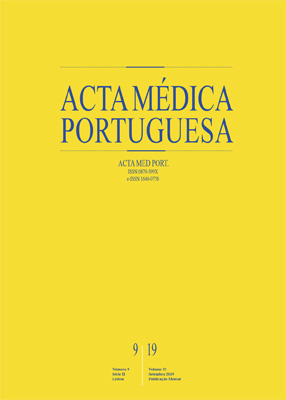The Epidemiological Profile of the Isolation of ‘Problem’ Microorganisms
DOI:
https://doi.org/10.20344/amp.10838Keywords:
Drug Resistance, Microbial, Infection/epidemiology, PortugalAbstract
Introduction: Infections are a major problem and the presence of drug-resistant microorganisms has significant clinical and economic impact. The present study aims to evaluate the epidemiological profile of “problem” microorganisms isolated in a hospital in the north of Portugal.
Material and Methods: All isolated microorganisms were analyzed, between January 2014 and June 2015. Data obtained was then processed using statistical software.
Results: We analyzed 8146 microbiological isolations and found a prevalence of 23% of ‘problem’ microorganisms (in descending order of frequency: Enterococcus, Pseudomonas, Staphylococcus aureus e Streptococcus pneumonia), 57.55% of which isolated in male patients. The most frequent mechanism of drug resistance for the overall sample was the production of extended-spectrum beta-lactamase, and resistance to oxacillin for ‘problem’ microorganisms.
Discussion: In this sample, we observed a much higher prevalence of ‘problem’ microorganisms than that reported in other countries, which shows the need of improvement of surveillance mechanisms and treatment of these cases. Microorganisms that showed higher resistance were Staphylococcus aureus (resistant to oxacillin) and Enterococcus (resistant to vancomycin). Those were isolated in patients with a higher mean age compared to non-resistant microorganisms. Most of these microorganisms were isolated in hospitalized patients or intermediate and intensive care units, what relates them with healthcare associated infections.
Conclusion: The prevalence of infection by ‘problem’ microorganisms during the studied period was 23%. The detection and control of the spread of these microorganisms are paramount due to its impact on health costs, morbidity and survival of patients.
Downloads
Downloads
Published
How to Cite
Issue
Section
License
All the articles published in the AMP are open access and comply with the requirements of funding agencies or academic institutions. The AMP is governed by the terms of the Creative Commons ‘Attribution – Non-Commercial Use - (CC-BY-NC)’ license, regarding the use by third parties.
It is the author’s responsibility to obtain approval for the reproduction of figures, tables, etc. from other publications.
Upon acceptance of an article for publication, the authors will be asked to complete the ICMJE “Copyright Liability and Copyright Sharing Statement “(http://www.actamedicaportuguesa.com/info/AMP-NormasPublicacao.pdf) and the “Declaration of Potential Conflicts of Interest” (http:// www.icmje.org/conflicts-of-interest). An e-mail will be sent to the corresponding author to acknowledge receipt of the manuscript.
After publication, the authors are authorised to make their articles available in repositories of their institutions of origin, as long as they always mention where they were published and according to the Creative Commons license.









